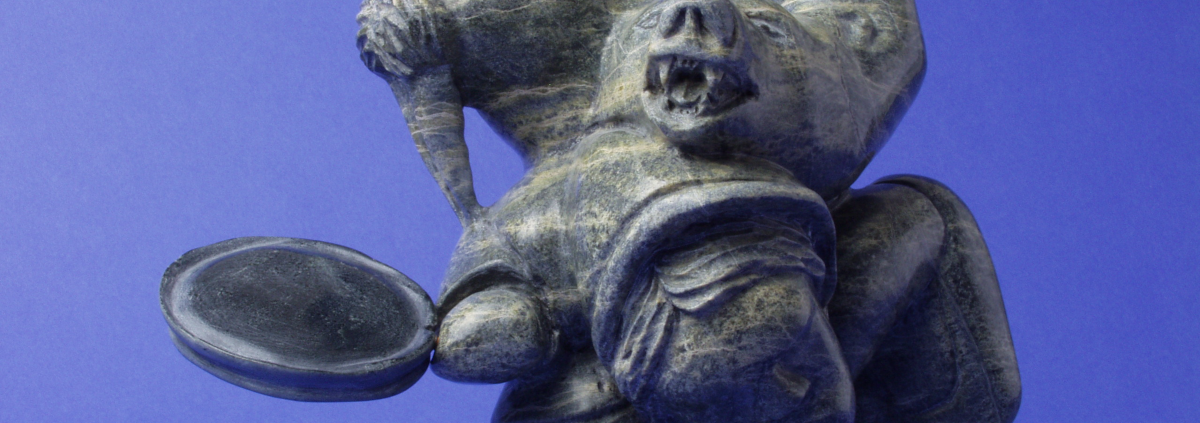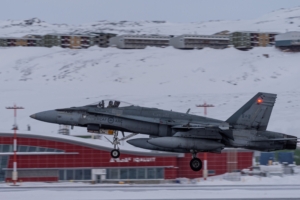Iqaluit – and its geopolitical importance
After James Houston visited the communities of Inukjuak and Puvirnituq in 1949 and 1950, he turned his attention to Baffin Island. Accompanied by his wife Alma Bardon, James Houston embarked on an expedition to Baffin Island in January 1951, shortly after their marriage. Instead of a conventional honeymoon, they took the chance to explore and document the handicraft potential of Baffin Island.
Their journey began with a flight from Montreal to Goose Bay, Labrador, with the Royal Canadian Air Force. From there, they continued their flight to Iqaluit, which at the time was a jointly controlled air base. This journey would have been quite an adventure, considering the remote and rugged nature of the Canadian Arctic at that time.
CF-18 fighters taking off from Iqaluit, NU, January 2021
(© DND/CAF)
Arriving in Iqaluit on February 17, 1951, they stayed only for one month. During their time there, they observed that many Inuit were employed in providing support services to the Royal Canadian Air Force (RCAF) base, highlighting the significant influence of the military presence in the region. The air base in Iqaluit was part of the DEW line (late 1950s until early 1990s) within “The Northern Defense System”. Although it is no longer called the Northern Defense System today, it still holds significant importance due to several key factors:
- Geopolitical Significance: The Canadian Arctic is strategically positioned between North America, Europe, and Asia. As such, it holds geopolitical importance for Canada in terms of national security, defense, and sovereignty. The region serves as a vital gateway for monitoring and responding to potential threats, including those related to maritime security, resource exploitation, and territorial disputes.
- Sovereignty and Territorial Integrity: Canada asserts its sovereignty over the Arctic through the presence of military installations, including the Northern Defense System. These installations demonstrate Canada’s commitment to protecting its northern territories and ensuring the integrity of its borders in the face of potential challenges from other nations or actors.
- Surveillance and Early Warning: The Northern Defense System includes radar installations, monitoring stations, and other surveillance infrastructure designed to detect and track air and maritime traffic in the Arctic region. This early warning capability is crucial for identifying and responding to potential security threats, including unauthorized or suspicious incursions into Canadian airspace or waters.
- Search and Rescue Operations: The harsh and remote environment of the Canadian Arctic presents unique challenges for search and rescue operations. The Northern Defense System plays a critical role in coordinating and supporting search and rescue efforts, providing assistance to aircraft, ships, and individuals in distress in the vast and often inhospitable Arctic landscape.
- Support for Northern Communities: In addition to its defense and security functions, the Northern Defense System also provides important support and services to northern communities. This includes infrastructure development, employment opportunities, and logistical support, contributing to the economic and social well-being of residents living in remote and isolated areas of the Canadian Arctic.
For the mission of the Houstons, this was kind of a setback. But anyway, they noted that the sewing of sealskins, used to make items such as slippers, mitts, and coats, had a market at the RCAF base. Also, there was no ivory available during their stay, but the Houstons were still able to acquire some soapstone carvings. Overall, the Houstons’ observations during their stay in Iqaluit provided valuable insights into the economic activities and artistic traditions of the local Inuit community, laying the groundwork for future collaborations and developments in the promotion of Inuit art and culture.
Some of the sought-after artists today came or still come from Iqaluit. Henry Evaluardjuk (1923-2007), Pootoogook Qiatsuk (b. 1959), Jackoposie Upakak (1948-2015), Joamie Aipeelee (1963-2020), Morris Alorut (b. 1963), Mathew Nugingaq (b. 1964).
Sources of information: “www.joint-forces.com” and “Early Masters: Inuit Sculpture 1949-1955” (by Darlene CowardWight, The Winnipeg Art Gallery, 2006)




